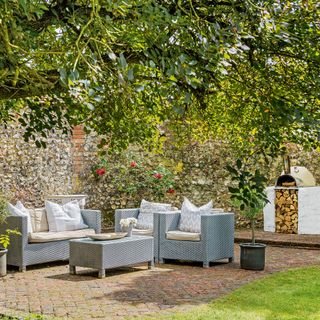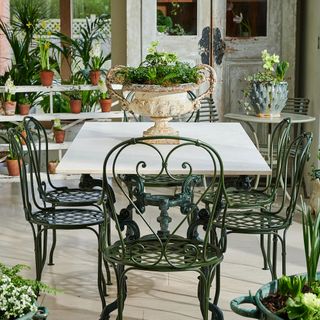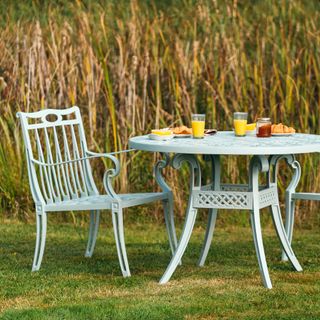No matter how adept you may be at interior design, it’s common to falter when stepping into your garden. Learning how to choose outdoor furniture is a skill that, once mastered, will transform this space.
These days, gardens are becoming more and more an extension of our home. They are extra living rooms, kitchens and even home offices. Instead of merely setting up ad hoc seating, it’s important to take the time to find the best furniture for your outdoor space so you can use it to its fullest potential.
The best place to start when working out how to choose outdoor furniture is by analysing your needs. Different homes and lifestyles have different requirements, and it’s key to identify these at the beginning of the process.
Whatever size or style your garden is, discover how to choose outdoor furniture with our expert-led guide.
1. Find the right style for your space
‘If you are looking to entertain family and friends, you are likely to opt for more casual dining options over a traditional dining set,’ notes Tim Penell, Head of Sales and Marketing at Bramblecrest. ‘These offer the versatility of dual height tables (simple to switch from coffee to dining height) or consider a set with a fire pit table and feel warm long after sunset. Whereas if you are looking for outdoor furniture for summer parties, you might be looking for bar sets or to keep drinks chilled with an ice bucket coffee table.’
As with interiors, it’s important to take the environment into consideration when buying furniture. A useful place to start is by deciding whether you want your garden furniture to complement or contrast with your home. ‘If you live in a very modern house, you might go for furniture with lots of minimalist lines, or contrast with furniture that provides a cosy and comfy ambience,’ says Simon Hudson, Managing Director, Oxley’s.
For a more cohesive feel, stick with furniture that reflects your home and the garden. ‘A traditional property with a classically designed garden would suit 19th century or early 20th century garden antique furniture,’ notes Caryl Tincknell, founder of Violet Grey. ‘A contemporary property and garden would be better suited to mid-century items. You can get a real sense of the history of a garden and work in pieces from there.’
Style also dictates material choice to an extent. ‘It’s best to consider the overall look you want to achieve and how you’re planning to use your outdoor space,’ advises Jonny Brierley, CEO, Moda Furnishings. ‘Aluminium is best for those wanting to achieve a contemporary look, whereas rattan is perfect for achieving a more traditional style.’
2. Find the right material

One of the most confusing aspects of discovering how to choose outdoor furniture is that wide range of materials on the market. It can be tricky to know which is best for your needs, but each has their pros and cons to keep in mind.
- Rattan
‘Rattan comes in a variety of styles, weaves and materials, that drastically vary in quality,’ says Jonny from Moda. ‘PE is a synthetic Polyethylene resin that opposes a natural wicker rattan. Unlike natural rattan, PE rattan is far more durable and as a result, requires less maintenance, it is also capable of handling much more unfriendly weather with minimal wear and tear. With natural wicker rattan, you will need to keep your furniture inside and likely treat it to maximise its longevity.’
‘There are also different types of weaves that you can choose from,’ continues Jonny. ‘Flat weave rattan is perhaps one of the most popular choices and one of the cheapest. Flat weaves are also the lightest making your furniture much easier to move around and easier to clean. Curved weave offers a more luxurious and traditional appearance. It needs more cleaning than a flat weave, but it’s also less brittle and can last longer.’
- Wood
Wood is one of the most classic choices in outdoor furniture, and will offer that traditional, elegant look. However, it can require a fair amount of maintenance. ‘As it's natural, spores, lichens and stains grow on it so it needs annual sanding and oiling,’ notes Simon from Oxley’s.
Although garden furniture comes in a variety of woods, one of the most popular is teak. ‘A naturally good looking material, teak contains high levels of oil making it weather-resistant and able to withstand exposure to the variable British climate,’ points out Tim from Bramblecrest. 'Left untreated, teak furniture will mellow to a silver grey colour over time.’
- Metal
Aluminium and steel are the two most widely used materials for metal outdoor furniture. The latter, although more traditional, has more potential issues. ‘Steel is extremely robust and can look stunning in a minimalist setting,’ says Simon from Oxley’s. 'But it is very heavy and, as a ferrous metal, will eventually rust.’
For these reasons, aluminium is a more popular choice. ‘Aluminium furniture is likely to be favoured by those who prefer a more contemporary look to their outdoor space. There is a wide choice of styles available with frames and cushions in a variety of colours,’ says Tim from Blamblecrest. ‘Aluminium furniture is lightweight, rust-free and easy to maintain.’
‘With aluminium’ adds Jonny from Moda, ‘it is vital that the frame should have fully welded joints and be finished with multiple coatings of high-quality paint to ensure longevity and durability.’
- Glass
Glass isn’t used overly widely in outdoor furniture, but if you do select a table with glass, keep in mind some safety aspects. ‘It’s important to look for toughened safety glass,’ says Moda’s Jonny. ‘Look for 8mm toughened safety glass to ensure product longevity.’
3. Keep the environment in mind

As with every other area of our lives, it’s our responsibility to consider the eco-impacts of our garden furniture.
There are a few ways to ensure you’re taking care of the planet while creating a stylish outdoor space. For instance, like we do with interiors and fashion, look to buying second hand or antiques. Even with restoration, antique pieces have a very low carbon footprint when compared to new,’ says Caryl from Violet Grey. ‘We are seeing more and more customers choose antique garden furniture for this very reason.’
Aluminium is another eco-friendly choice. ‘It is infinitely recyclable and can be reused to make new furniture sets, making it one of the most sustainable resources there is,’ notes Simon from Oxley’s.
Wood can be eco-friendly if from a managed plantation, so try and choose items which are FSC assured.
In terms of rattan and PE rattan products, speak to your supplier for information. Many are made from recyclable materials and can be recycled in specialist facilities.
4. Measure up

‘The size of your garden will be the biggest limitation on what furniture set you choose,’ says Simon from Oxley’s. ‘You will need to marry the amount of space you have available and how you need it to work for you. As a rule, try not to fill more than two-thirds of your patio area with furniture, as this can look cluttered.’
Be careful not to over or underwhelm a patio area. 'You may want to keep a clear area for other accessories such as planters and lanterns,’ advises Bramblecrest’s Tim. ‘You may also want to allow space for a storage box for cushions and covers when not in use.’
Remember that less is more. You need space for everyone to be able to be comfortable, but also leave space so that guests can walk around with ease. Corner and L-shaped sofas are a good way of making good use of available space, for example.
5. Think about weight

One thing people often forget when discovering how to buy outdoor furniture is the importance of weight. Just as with size, how heavy - or light - your pieces are is useful to keep in mind.
‘Iron and steel are very heavy materials,’ notes Simon from Oxley’s. ‘If you like to change up your space frequently by moving your garden furniture, you should bear this in mind.’
‘By contrast, light furniture, such as low-cost plastic options, can also present a problem, as it is likely to be blown around in harsh weather and may be damaged,' continues Simon. 'Ideally, opt for furniture that is robust enough to withstand the British weather, but not so heavy that it’s a challenge to move.’
6. Consider what maintenance is required

It’s an annoying fact of life that everything requires upkeep and maintenance to keep things in the best condition possible. Because of this, make sure you choose garden furniture which works with the level of maintenance that you’re realistically able - or willing - to provide.
‘If you are choosing a rattan set, it’s important to know whether the rattan contains PE (Polyethylene) and what the frame is made from, as this will affect the maintenance of your set,’ notes Jonny from Moda. ‘The best combination for weather resistance is PE rattan along with powder-coated aluminium frames. PE rattan has wonderful weather resistance and powder coated aluminium frames won’t rust.’
‘Thanks to this, minimal maintenance is required, although any set will still need a clean from time to time, removing dirt and mildew,’ continues Jonny. ‘To do this we recommend a brush or vacuum. For smaller awkward spaces where dirt is difficult to remove, we recommend something smaller like a toothbrush. Avoid harsh chemicals and stick to diluted washing up liquid.’
A lot of outdoor furniture is designed to be left outside year round, so check with your supplier whether your choice needs to be moved elsewhere for the winter months. ‘During periods of non-use, we suggest that furniture is covered to protect from garden debris and to keep the furniture clean,’ advises Tim from Bramblecrest. ‘We also recommend that cushions are removed to a dry garage, outbuilding or loft space. If that’s not possible, cover your furniture with the cushions on but check weekly to prevent a build-up of condensation.’
7. Keep your heating in mind

The best fire pits are a must-have addition to gardens, so make sure to consider this when deciding how to choose outdoor furniture for your space.
‘We recommend thinking about the look of the fire pit to make sure it compliments the furniture,’ says Jonny from Moda. ‘For example, concrete fire pits go beautifully with grey aluminium contemporary collections.'
‘Spaces with fire pits create a really intimate feel, so think about your experience whilst you’re in that space . You want everything to hand so you don’t have to go back into the cold,’ continues Jonny. ‘Think drinks coolers, storage boxes for blankets and so on. Reclining sofas and chairs can be a great way to transition from day to night when you’ve lit your fire pit.’

